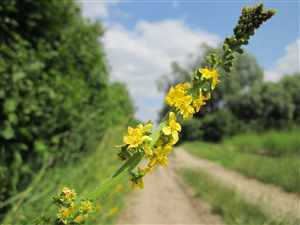Agrimony (Agrimonia eupatoria)
Main Facts about Agrimony

Agrimony is a pretty, hardy perennial with slender long spikes of aromatic, pale yellow flowers, often found growing wild in summer hedgerows, meadow and waste ground. It flowers from June to September. The flowers become prickly seed burrs with hooked bristles that commonly attach themselves to passersby. Parts used – leaves, stems, and flowers.
Once used as a throat-soothing gargle by speakers and singers, Agrimony has astringent properties that make it a useful medicinal herb. The botanical name may come from the Greek “arghemon”, translating to “albugo”, an eye disease once treated with the plant. Another explanation is that the name comes from the Latin “agrimoenia”, or “defender of the fields”, because of the plant’s tendency to grow in groupings near fields.
Agrimony has been used to treat diarrhea; to staunch bleeding wounds; and to soothe inflammation of the skin, throat, mouth, and pharynx; and for many other therapeutic purposes. It was a component of a special remedy produced in the 14th century to treat the gaping wounds produced by a primitive gun known as the arquebus.
Using Agrimony
The leaves, stems, and flowers contain astringent and antibacterial tannins. Taken internally, Agrimony makes an excellent digestive remedy, improving the secretion of digestive juices and of bile from the liver and gall bladder and enhancing the absorption of food. The astringent tannins protect the lining of the digestive tract from irritation and inflammation and help to heal inflammatory problems such as gastritis, colitis and peptic ulcers. Agrimony can be taken to relieve diarrhea, and to treat leaver and gall-bladder problems. It is often used with carminatives for digestive problems.
In studies conducted with laboratory animals, Agrimony has been shown to have liver-protecting effects, which are thought to be due to its anti-inflammatory and antioxidant properties. A related species, Agrimonia pilosa, is used in traditional Chinese medicine to treat nosebleeds, bleeding gums, and blood in the urine.
Agrimony has a diuretic action, helping to cleanse toxins from the system, and is helpful when treating arthritis and gout.
Agrimony makes a good gargle for sore throats, laryngitis, and eyewash for inflammation of the eyes.
As an ointment it will aid the healing of wounds and bruises.
Agrimony is well known for the yellow dye that can be made from its leaves and stems.
Infuse 1-2 tsp. of the dried herb with 1 cup of boiling water for 10-15 min. Drink 3 times a day.
Agrimony is a remedy for: Arthritis
How to grow Agrimony
Propagate by sowing seeds from either February to May or August to November, in well-drained soil and full sun.
Plant it in groups of six to eight, leaving 6 inches between plants. Harvest blooms in midsummer, before they begin to develop into burrs. To keep the plants from spreading aggressively, cut the stalks before the seeds begin to drop. For yellow dye, harvest the leaves and stems in late fall. For a lighter buff color, harvest in early fall. Propagate by gathering seeds, or divide the roots of established plants. The whole of the plant above ground should be collected when the flowers are just blooming.
| Acacia tree |
Alfalfa
|